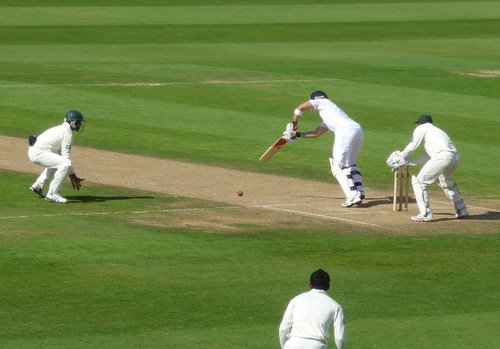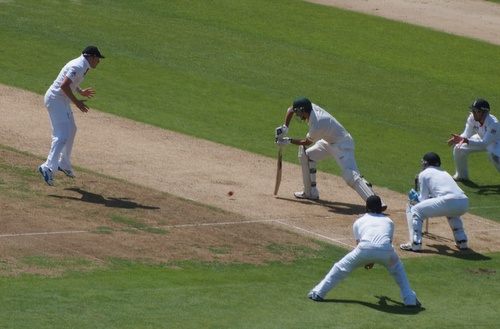
For the last two weeks I have been judging wine at the Oval. It’s one of the most famous cricket grounds in the world, and was home to the first test match between Australia and England on English soil, in 1880. [We won.]
I’m a big fan of cricket. I fell in love with it aged about 11. It’s a sport that, when it grips you, it really grips you. From the age of 13 I went to see a lot of cricket, mainly at Lords, another famous London ground. And whenever we had a tennis ball, a bat of some sort, and a reasonably flat patch of ground, we played for hours, making up informal rules depending on the location (hit a fence on the full and you are out caught, for example).
There are many similarities between cricket and wine. If you listen to the discussions among cricket enthusiasts, they are similar to the internal discussions that take place in the wine trade.

I love the way that cricket decided on a set of rules, after a period of experimentation, and then stuck with the winning formula. For example, despite all advances in technology, cricket is all about the grass. Great care is taken in preparing the narrow strip of grass in the middle of the pitch on which the game is played. The grass is grown, cut short, subjected to heavy rolling, dries out, and then plays a vital role in how the game progresses. The properties of this patch of grass determine how the ball bounces, which massively affects the progress of the game. Fast bowlers want a particular sort of pitch, spin bowlers another kind, and batsmen another kind. Some pitches, badly prepared, make both bowling and batting difficult. It’s not possible to produce an artificial pitch that satisfies top players.
The cricket ball is also a link to tradition. It is still made from a core of cork, surrounded in string, and with a four-piece leather cases that is sewn together. The seam is a vital part of the ball, because it sticks out slightly. And a new ball is shiny and hard: as the game progresses the bowling side tries to keep one side shiny while allowing the other to scuff, which helps bowlers who like to swing the ball in the air. The age of the ball and its properties are also a vital part of the game. The ball is hard, and sometimes it hurts to stop it or catch it, and you can be badly injured by it. This isn’t ideal, but it is part of the game.
Wine, like cricket, has its own traditions. At a certain stage, the rules of what makes wine wine were determined, and this winning formula has persisted. When people fall in love with wine it really grabs them. There is a strong link with tradition. Those who would like to see the rules relaxed point to Roman times when wine was commonly adulterated and blended with other things (to a small extent this still exists with Retsina, and the use of oak can add flavour, too, but these traditional adulterations are accepted), but for a long time the rules around wine production have been set. It’s fermented grape juice, with some defined processing aids and corrections and preservatives allowed.

The cricket crowd are worried about attracting younger fans. The traditional gold standard for a cricket match is the Test Match. This is an international match with two innings per team, with unlimited overs, and five days are allotted to each game (it’s possible for the game not to reach a conclusion in this time frame). This is beautifully old fashioned, and it’s also tremendously compelling when the game goes well, but not everyone agrees.
So the cricket authorities introduced new formats of the game, beginning in the 1960s when ‘limited overs’ cricket was introduced. Limited? Instead of games taking three, four or five days, each team is only allowed to bat for a certain time, and the game is over in a single day. Then, in the 1980s, they began using a white ball for limited overs games, as opposed to the traditional red ball, and teams were allowed to wear coloured clothing (rather than whites). Then they shortened the games further, with the introduction of 20:20, a game of 20 overs per side that takes three hours to compete, rather than a day, and where there’s much more intense action. The latest innovation is the planned introduction of a new format that’s even shorter, called The Hundred – a move that is mired in controversy. So the game now has very different formats, each with its own advocates.

Wine has also been thinking about attracting the next generation. The immediate focus has been to get millennials drinking wine rather than spirits and beer. This is a noble goal, and many have suggested that this can be achieved by various innovative strategies. Of course, like cricket, wine has very strong traditions and a link with history, and can be seen to be outmoded in the modern world.
So we have these conversations around innovation. People don’t like wine, we think. So let’s make wine less like wine, and more like things they do like. We sweeten wine up, we discuss adding fruit flavourings to it, we mess around with packaging. It’s a very similar conversation to what happens around cricket.
But by doing this we risk losing the specialness of both. After all, cricket is a very singular game, and it has a set of rules that work. These have been modified only slightly over the years, in ways that have improved the game without actually changing its nature.
Innovation is important, but changing the rules of something singular and compelling has to be done with caution. Perhaps wine, like cricket, will never have universal appeal. How much change should we encourage, and how much should we resist? The key thing is to decide on what the essential core of wine or cricket is, and then to preserve this, while embracing innovation that stays within appropriate boundaries. Same for wine. Everything changes, and evolution is inevitable. But it pays to be wise, and once something precious is lost, it is usually lost forever.
Leave a Comment on Why wine is a bit like cricket, and both are fabulous
